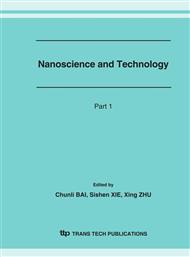p.877
p.885
p.889
p.893
p.897
p.901
p.905
p.909
p.913
Biomimetic Synthesis of Nanoporous Silica Templated by Copolypeptide in the Organic Gel System
Abstract:
At neutral pH value and room temperature, nanoporous silica has been prepared through self-organization of synthetic block copolypeptide Poly(ethyl glycol)-b-poly(L-phenylalanine) (MPEG44–b-Phe7) and silicane in the organic gel system. In this system, π-π interaction between anilino-methyl triethoxy silicane and block copolypeptide MPEG44–b-Phe7 effectively controlled the growth of the silica precursors. SEM images show that the size of silica is relatively uniform with the length ranging from 20~50 μm and the diameter ranging from 2~5 μm. FT-IR spectra reveals that there exists nanoporous structure in the calcined sample. N2 adsorption-desorption isotherms are consistent with the results of FT-IR spectra and show a type-IV isotherm with H1-type hysteresis loop, which means the presence of uniform nanoporous structure. This sample has a BET surface area of 171 m2.g-1 and a pore volume of 0.55 cm3.g-1. The average pore size calculated by BJH method is 10 nm. Our results suggest a new biomimetic avenue for synthesis of nanoporous inorganic materials templated by the self-organization of copolypeptide .
Info:
Periodical:
Pages:
897-900
Citation:
Online since:
March 2007
Authors:
Price:
Сopyright:
© 2007 Trans Tech Publications Ltd. All Rights Reserved
Share:
Citation:


